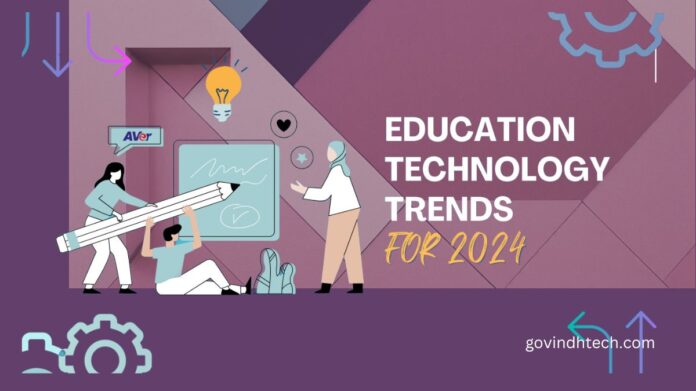What is Educational Technology?
Educational Technology includes media and tools that facilitate knowledge transfer. Software, smart devices, and electronics fall under this broad definition. These enable teachers to teach remotely, improve knowledge retention, engage students, and run more efficiently.
6 Ways Modern Technology Improves Education
Today’s students expect more than just a lecture in a classroom. Educational Technology offers exciting new ways to interact and learn, helping faculty prepare students for future workplaces.
Tech in the classroom has many benefits:
1. It Supports Multiple Learning Styles
Students have different needs and learn differently. These realities can make it hard for your employees to meet diverse needs.
Modern technology supports learning styles and needs through online platforms, interactive tools, and collaborative experimentation. These solutions enable your teachers to use various mediums. They also let students participate their way. For instance, educators can use technology to give students multiple ways to demonstrate their knowledge. This method customizes education while still providing value.
2. It Improves Communication and Collaboration
Your staff, students, and parents can communicate better with modern technology. Electronic tools allow students to make suggestions or ask questions they may be shy about in class. Parents and teachers can use email for routine communication and video tools for parent-teacher conferences.
Technology solutions foster student collaboration too. Students can collaborate on projects via text, video, and online forums. Current and future programs can help teachers track individual and group contributions.
3. It prepares students for life
Businesses today rely on technology to run and improve. Tech skills are crucial for your graduates, whether they operate expensive equipment or design the next space shuttle. Your campus’s classrooms are ideal for teaching students the basics they need to use technology in the workplace.
4. It Engages
Education becomes more interactive with technology. Users become more involved with their tools. Knowledge retention, subject interest, and lesson engagement can improve with this association.
5.Adaptive Learning Systems
Technology makes learning more interactive and engaging, improving student comprehension and retention. Online resources allow students to learn more than textbooks and improve their research skills for finding reliable sources.
6. It Allows Diversity
Disability and special needs students can benefit from technology, making learning more inclusive. Voice-to-text, captions, descriptions, and mouse and keyboard changes can enhance classroom experiences for pupils regardless of disabilities.
Latest Trends in Educational Technology
Internet Learning Platforms
Online learning platforms are a major education trend. Learners can access a variety of courses and resources from home on Coursera, edX, and Khan Academy. Online learning’s flexibility and accessibility have broken down geographical barriers and made education available worldwide.
Adjustable Learning Technologies
Adaptive learning technologies personalize education using data and algorithms. These technologies monitor student progress and adjust material difficulty and pace. This personalized approach lets students learn at their own pace, making learning more effective and engaging.
Augmented Reality in Education
VR and AR provide immersive and interactive educational experiences. While AR adds digital information to the real world, VR transports students to historical events or distant places. These technologies enable hands-on learning, making complex concepts more tangible and improving comprehension.
Collaboration Tools
Technology helps students and teachers collaborate across borders. Google Workspace, Microsoft Teams, and Slack enable real-time collaboration, file sharing, and communication. These platforms foster teamwork and teach students workplace skills.
Learning Transformation in Educational technology
Artificial Intelligence in Education
By streamlining managerial duties, tailoring learning, and providing data-driven insights, AI is changing education. Student questions are answered by AI chatbots, as machine learning algorithms improve performance. These innovations help teachers better meet student needs.
Gamification in Learning
Gamification boosts motivation and engagement in education. Educational games and simulations make learning fun and improve retention. This innovative approach accommodates different learning styles and promotes active learning.
Credentialing Blockchain
Blockchain technology is changing academic credential verification and storage. Blockchain lets schools create secure, tamper-proof academic records. This simplifies credential verification and gives students more control over their educational data.
Educational Robotics
Education in robotics goes beyond STEM subjects. Coding classes use educational robots to teach problem-solving and computational thinking. Robots can also help special education students with multiple learning needs with personalized support.
Issues with Technology Integration in Education:
Digital Divide
Technology can democratize education, but the digital divide remains. Devices and high-speed internet access vary by student, limiting educational opportunities. To ensure all students benefit from technology in education, this gap must be closed.
Privacy and Security Issues
Student data privacy and security are concerns as education uses more technology. To protect sensitive data and student privacy, schools must implement strong cybersecurity measures.
Professional Development and Teacher Training
Many educators were not trained to use technology in class. Effective implementation requires ongoing professional development to help teachers adopt new tools and methods. Proper training allows educators to maximize technology’s learning benefits.
Overemphasize Educational Technology
Technology is useful, but overuse can lead to neglecting human connection and traditional teaching methods. To provide a well-rounded education, technology, and traditional pedagogy must be balanced.
However, the digital divide and privacy issues must be addressed to ensure that all members can benefit from educational technology. In this digital age, balancing technology’s power with effective and inclusive education is crucial.


